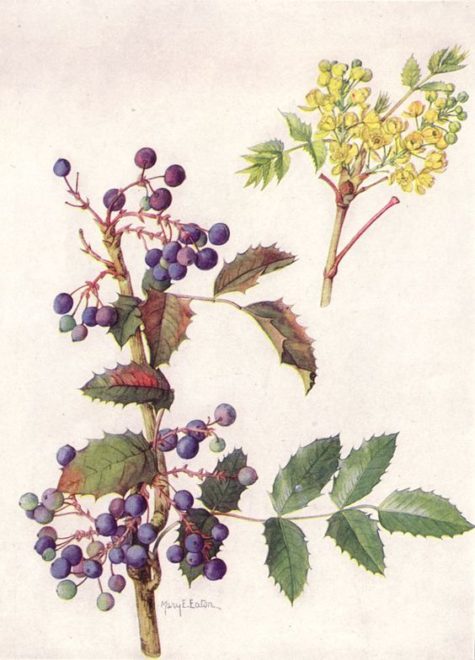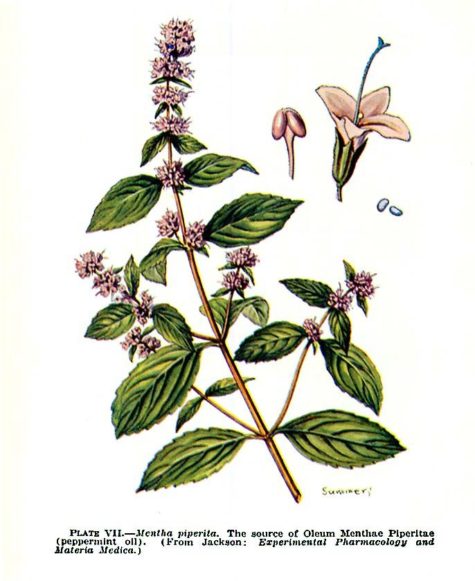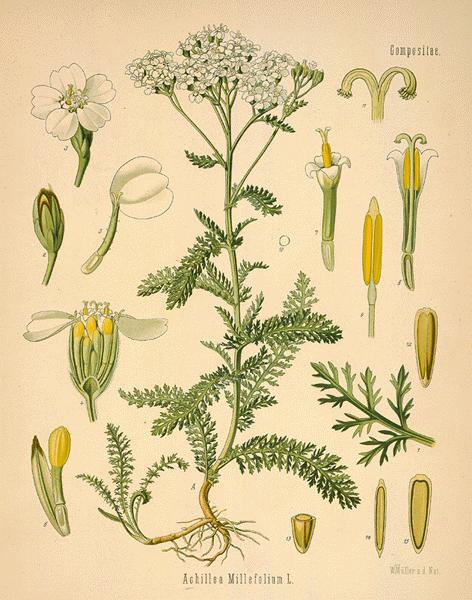Tonic
Oregon Grape
- Scientific Name: Berberis Aquifolium
- Common Name: Barberry
- Plant Family: Berberidaceae
- Parts Used: Rhizome and Roots, Bark, Fruits
- Actions: Alterative, cholagogue, diuretic, laxative and tonic
Description:
Several varieties of the subgenus Mahonia contribute to the drug of commerce under the name of Berberis aquifolium. It is a quickly-growing shrub about 6 feet high: the oddly compound leaves have no spine at the base; they are evergreen and shining. The flowers grow in terminal racemes, are small and yellowish-green in color, and the purple berries are three- to nine-seeded. The bark is brown on the surface and yellow beneath. The root is from 1/2 inch in diameter to 3 inches at the base of the stem, odorless, and with a bitter taste. The shrub was introduced into England from North America in 1823. It was formerly known as Mahonia aquifolia and is very hardy.
Note:It should not be used with Glycyrrhiza species (Liquorice) because this nullifies the effects of the berberine.
The Basics:
Oregon grape was often used by several native North American Indian tribes to treat loss of appetite and debility. Its current herbal use is mainly in the treatment of gastritis and general digestive weakness, to stimulate the kidney and gallbladder function and to reduce catarrhal problems. The root and root bark is alterative, blood tonic, cholagogue, diuretic, laxative and tonic. It improves the digestion and absorption and is taken internally in the treatment of psoriasis, syphilis, haemorrhages, stomach complaints and impure blood conditions. Externally, it has been used as a gargle for sore throats and as a wash for blurry or bloodshot eyes.
The blue fruits are tart and improve after frost. They are often gathered for jelly or wine. Used to treat a wide variety of ailments, Oregon Grape species contain the extremely potent alkaloid, berberine, (also found in goldenseal) which is antiseptic and stimulates the liver and spleen.
The fruit is an excellent gentle and safe laxative. Berberine, universally present in rhizomes of Mahonia species, has marked antibacterial effects and is used as a bitter tonic. Since it is not appreciably absorbed by the body, it is used orally in the treatment of various enteric infections, especially bacterial dysentery.
Berberine has also shown anti-tumor activity.
It is one of the best alterative blood purifiers and liver stimulants. Uses for the Oregon Grape Root include weak digestion, flatulence, jaundice, blood impurities, and as a general tonic to the whole system.
A decoction (instructions below) will be found to be a wonderful blood purifier and will restore health to many who are suffering from a sluggish liver, weak stomach, indigestion, and sallow skin.
Years ago, it was given to children, and said to create appetite and promote digestion, and increase strength and vitality. The current medical thinking is that it is not safe for children, especially infants, or pregnant or nursing women. (see information at the bottom of the post)
Continue reading
Peppermint
- Scientific Name: Mentha x piperita
- Plant Family: Labiatae
- Parts Used: Aerial parts
- Actions: Anodyne, Antiseptic, Antispasmodic, Carminative, Cholagogue, Diaphoretic, Refrigerant, Stomachic, Tonic. Vasodilator
- Constituents: Up to 2 % volatile oil containing menthol, menthone and jasmone; tannins, bitter principle
Variations:
There are several varieties of Peppermint. The two chief, the so-called ‘Black’ and ‘White’ mints are the ones extensively cultivated. Botanically there is little difference between them, but the stems and leaves of the ‘Black’ mint are tinged purplish-brown, while the stems of the ‘White’ variety are green, and the leaves are more coarsely serrated in the White. The oil furnished by the Black is of inferior quality, but more abundant than that obtained from the White, the yield of oil from which is generally only about four-fifths of that from an equal area of the Black, but it has a more delicate odor and obtains a higher price. The plant is also more delicate, being easily destroyed by frost or drought; it is principally grown for drying in bundles – technically termed ‘bunching,’ and is the kind chiefly dried for herbalists, the Black variety being more generally grown for the oil on account of its greater productivity and hardiness.
The Basics:
White Peppermint is a very important and commonly used remedy, being employed by allopathic doctors as well as herbalists. It is also widely used as a domestic remedy. A tea made from the leaves has traditionally been used in the treatment of fevers, headaches, digestive disorders (especially flatulence) and various minor ailments. An infusion is used in the treatment of irritable bowel syndrome, digestive problems, spastic colon etc. Externally a lotion is applied to the skin to relieve pain and reduce sensitivity.
The essential oil in the leaves is antiseptic and strongly antibacterial, though it is toxic in large doses. When diluted it can be used as an inhalant and chest rub for respiratory infections. The essential oil is used in aromatherapy. Its keyword is “Cooling”.
Peppermint is one of the best carminative agents available. It has a relaxing effect on the visceral muscles, anti-flatulent properties and stimulates bile and digestive juice secretion, and so can relieve intestinal colic, flatulent dyspepsia and other associated conditions.
The volatile oil acts as a mild anesthetic to the stomach wall, which helps to relieve the vomiting of pregnancy and travel sickness. Peppermint plays a role in the treatment of ulcerative colitis and Crohn’s disease. It is most valuable in the treatment of fevers and especially colds and flu.
As an inhalant it can be used as a temporary treatment for nasal catarrh. Where migraine headaches are associated with the digestion, this herb may be used. As a nervine it eases anxiety and tension. In painful periods it relieves the pain and eases tension. Externally it relieves itching and inflammation.
Peppermint oil is useful in combating flatulence and mild indigestion. Many over-the-counter stomach aids contain Peppermint to both enhance the taste as well as the effectiveness of the medicine. However, in a strange bit of irony, Peppermint is something of a trigger food for many suffering from acid reflux and may cause their symptoms to worsen.
How does it work? Peppermint oil seems to reduce spasms in the digestive tract. When applied to the skin, it can cause surface warmth, which relieves pain beneath the skin.
Continue reading
Yarrow
- Scientific Name: Achillea millefolium
- Plant Family: Compositae
- Parts Used: The whole plant – stems, leaves, flowers, collected in the wild state, in August, when in flower.
- Actions: Diaphoretic, Hypotensive, Astringent, Diuretic, Antiseptic, Anticatarrhal, Emmenagogue, Hepatic, Stimulant, Tonic, Mild Aromatic
The Basics:
Yarrow is a wound herb, astringent and healing, and rich in vitamins and minerals. Bind bruised fresh leaves to cuts, or make an ointment by pounding the flowers and mixing with coconut oil, or bathe wounds with yarrow tea. The tea is also a good tonic drink, it restores lost appetite and promotes perspiration during colds and fevers. Chew fresh leaves to soothe toothache.
Yarrow also lowers blood pressure due to a dilation of the peripheral vessels. It stimulates the digestion and tones the blood vessels. As a urinary antiseptic it is indicated in infections such as cystitis. It is considered to be a specific in thrombotic conditions associated with high blood pressure.
The flowers are often steamed and inhaled to treat hay fever and asthma and in teas for respiratory problems, as a wash for eczema and other skin conditions; and in chest rubs for cold, flu, and inflamed joints. Continue reading
Rennie Luttrull: queen-annes-lace-seeds
Rosanna: Spignel aka Bald Money
Annamarie Squatrito: Fumitory
EILEEN Klinghagen: Pumpkin
Mahmudul Hasan: Celery




